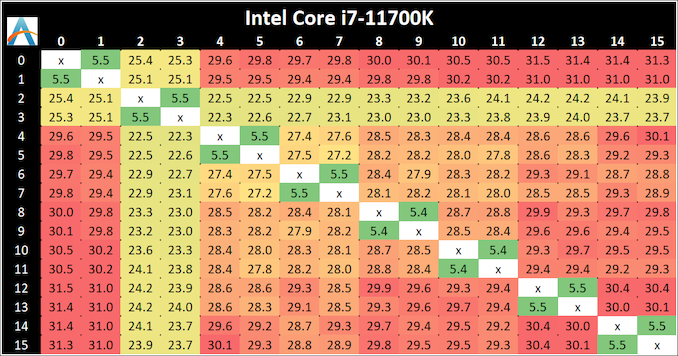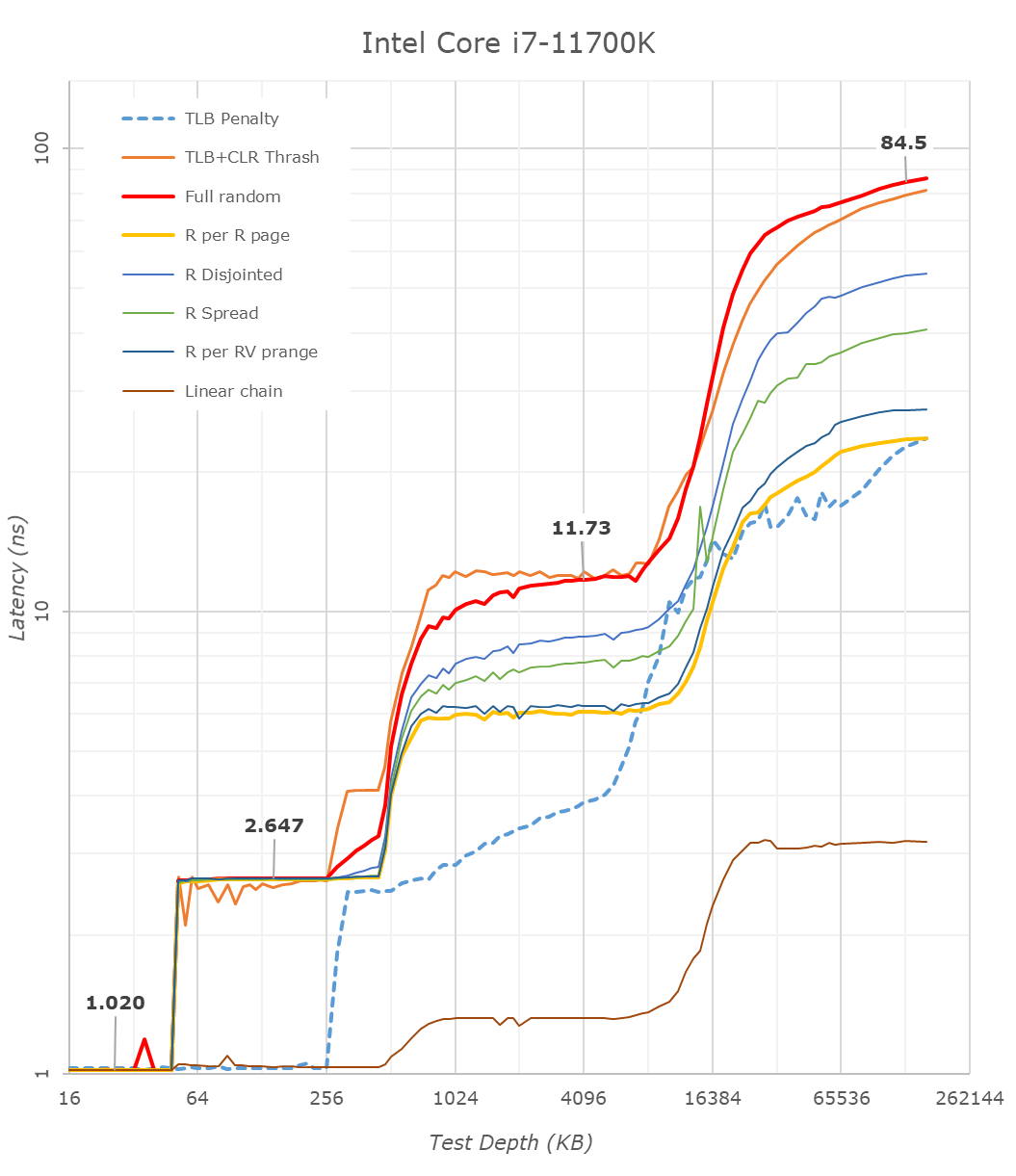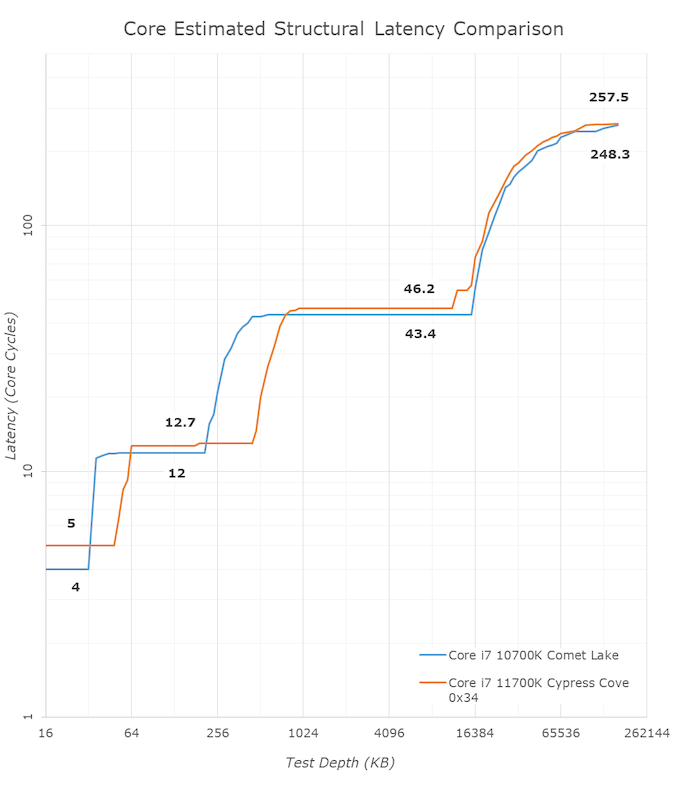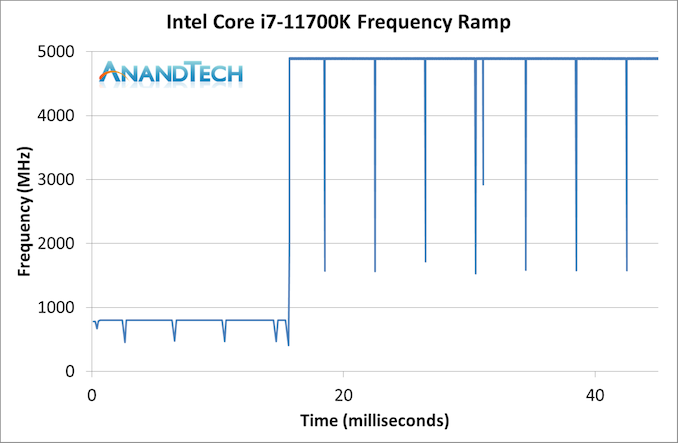Intel Core i7-11700K Review: Blasting Off with Rocket Lake
by Dr. Ian Cutress on March 5, 2021 4:30 PM EST- Posted in
- CPUs
- Intel
- 14nm
- Xe-LP
- Rocket Lake
- Cypress Cove
- i7-11700K
CPU Tests: Microbenchmarks
Core-to-Core Latency
As the core count of modern CPUs is growing, we are reaching a time when the time to access each core from a different core is no longer a constant. Even before the advent of heterogeneous SoC designs, processors built on large rings or meshes can have different latencies to access the nearest core compared to the furthest core. This rings true especially in multi-socket server environments.
But modern CPUs, even desktop and consumer CPUs, can have variable access latency to get to another core. For example, in the first generation Threadripper CPUs, we had four chips on the package, each with 8 threads, and each with a different core-to-core latency depending on if it was on-die or off-die. This gets more complex with products like Lakefield, which has two different communication buses depending on which core is talking to which.
If you are a regular reader of AnandTech’s CPU reviews, you will recognize our Core-to-Core latency test. It’s a great way to show exactly how groups of cores are laid out on the silicon. This is a custom in-house test built by Andrei, and we know there are competing tests out there, but we feel ours is the most accurate to how quick an access between two cores can happen.
The core-to-core numbers are interesting, being worse (higher) than the previous generation across the board. Here we are seeing, mostly, 28-30 nanoseconds, compared to 18-24 nanoseconds with the 10700K. This is part of the L3 latency regression, as shown in our next tests.
One pair of threads here are very fast to access all cores, some 5 ns faster than any others, which again makes the layout more puzzling.
Update 1: With microcode 0x34, we saw no update to the core-to-core latencies.
Cache-to-DRAM Latency
This is another in-house test built by Andrei, which showcases the access latency at all the points in the cache hierarchy for a single core. We start at 2 KiB, and probe the latency all the way through to 256 MB, which for most CPUs sits inside the DRAM (before you start saying 64-core TR has 256 MB of L3, it’s only 16 MB per core, so at 20 MB you are in DRAM).
Part of this test helps us understand the range of latencies for accessing a given level of cache, but also the transition between the cache levels gives insight into how different parts of the cache microarchitecture work, such as TLBs. As CPU microarchitects look at interesting and novel ways to design caches upon caches inside caches, this basic test proves to be very valuable.
Looking at the rough graph of the 11700K and the general boundaries of the cache hierarchies, we again see the changes of the microarchitecture that had first debuted in Intel’s Sunny Cove cores, such as the move from an L1D cache from 32KB to 48KB, as well as the doubling of the L2 cache from 256KB to 512KB.
The L3 cache on these parts look to be unchanged from a capacity perspective, featuring the same 16MB which is shared amongst the 8 cores of the chip.
On the DRAM side of things, we’re not seeing much change, albeit there is a small 2.1ns generational regression at the full random 128MB measurement point. We’re using identical RAM sticks at the same timings between the measurements here.
It’s to be noted that these slight regressions are also found across the cache hierarchies, with the new CPU, although it’s clocked slightly higher here, shows worse absolute latency than its predecessor, it’s also to be noted that AMD’s newest Zen3 based designs showcase also lower latency across the board.
With the new graph of the Core i7-11700K with microcode 0x34, the same cache structures are observed, however we are seeing better performance with L3.
The L1 cache structure is the same, and the L2 is of a similar latency. In our previous test, the L3 latency was 50.9 cycles, but with the new microcode is now at 45.1 cycles, and is now more in line with the L3 cache on Comet Lake.
Out at DRAM, our 128 MB point reduced from 82.4 nanoseconds to 72.8 nanoseconds, which is a 12% reduction, but not the +40% reduction that other media outlets are reporting as we feel our tools are more accurate. Similarly, for DRAM bandwidth, we are seeing a +12% memory bandwidth increase between 0x2C and 0x34, not the +50% bandwidth others are claiming. (BIOS 0x1B however, was significantly lower than this, resulting in a +50% bandwidth increase from 0x1B to 0x34.)
In the previous edition of our article, we questioned the previous L3 cycle being a larger than estimated regression. With the updated microcode, the smaller difference is still a regression, but more in line with our expectations. We are waiting to hear back from Intel what differences in the microcode encouraged this change.
Frequency Ramping
Both AMD and Intel over the past few years have introduced features to their processors that speed up the time from when a CPU moves from idle into a high powered state. The effect of this means that users can get peak performance quicker, but the biggest knock-on effect for this is with battery life in mobile devices, especially if a system can turbo up quick and turbo down quick, ensuring that it stays in the lowest and most efficient power state for as long as possible.
Intel’s technology is called SpeedShift, although SpeedShift was not enabled until Skylake.
One of the issues though with this technology is that sometimes the adjustments in frequency can be so fast, software cannot detect them. If the frequency is changing on the order of microseconds, but your software is only probing frequency in milliseconds (or seconds), then quick changes will be missed. Not only that, as an observer probing the frequency, you could be affecting the actual turbo performance. When the CPU is changing frequency, it essentially has to pause all compute while it aligns the frequency rate of the whole core.
We wrote an extensive review analysis piece on this, called ‘Reaching for Turbo: Aligning Perception with AMD’s Frequency Metrics’, due to an issue where users were not observing the peak turbo speeds for AMD’s processors.
We got around the issue by making the frequency probing the workload causing the turbo. The software is able to detect frequency adjustments on a microsecond scale, so we can see how well a system can get to those boost frequencies. Our Frequency Ramp tool has already been in use in a number of reviews.
Our ramp test shows a jump straight from 800 MHz up to 4900 MHz in around 17 milliseconds, or a frame at 60 Hz.














541 Comments
View All Comments
Oxford Guy - Wednesday, March 10, 2021 - link
Worse.Bulldozer came from a money-starved little company, a company that couldn’t capitalize on having the superior design because of Intel’s monopolization.
This chip is from the big rich company that stomped on AMD with dirty tricks.
So, no. As stupid as Bulldozer was, this CPU seems to be quite a bit more unjustified.
ThereSheGoes - Wednesday, March 10, 2021 - link
Well, the results in this article are clearly not just wrong, but very wrong. https://www.hardwareluxx.de/index.php/artikel/hard...Bagheera - Wednesday, March 10, 2021 - link
did you even read the article you linked? it's taking 5800X in most benchmarks just like the Anandtech review.if you mean the gaming benches in the other review - 3 games is a terrible sample size and it still loses to 5800x in 2 out of 3.
Beaver M. - Wednesday, March 10, 2021 - link
Look at the results with the new BIOS.This review here is obsolete.
Hifihedgehog - Friday, March 12, 2021 - link
LOL. Fanboy delusion.First off, let's take a quick looksie at the Cinebench R20 results:
https://www.hardwareluxx.de/index.php/artikel/hard...
When switching from BIOS version 0402 to 0603, the 11700K's single-threaded performance actually DROPS from a score of 609 to 600. And its multicore performance is still less than the 10900K and the 5800X.
Switching gears, the games are no less unflattering:
https://www.hardwareluxx.de/index.php/artikel/hard...
The 11700K there, regardless of which of the two BIOS releases it uses, often loses to the 10900K and Ryzen 5000 series. It loses to the Ryzen 5000 series and 10900K in THREE out of the four games: The Division 2, Metro Exodus, The Shadow of the Tomb Raider.
In short: dude, what are you smoking?
Beaver M. - Wednesday, March 10, 2021 - link
As expected new reviews with newer BIOS versions improve performance significantly and puts the numbers to expected levels as well.This was a quick shot of a review and I fear it has tainted Cutress reputation a lot, especially because he defended it that much, even on video.
Oxford Guy - Wednesday, March 10, 2021 - link
With what power consumption?Raising performance by pushing power even higher may improve things like FPS in gaming tests but it obscures the big picture.
Want to talk about reputation? Remember the giant fridge-sized chiller Intel surreptitiously used to give a benchmark demo? Or, remember the ‘GenuineIntel’ fiasco? Or, remember the cute trick of putting a black box CPU inside the one people pay for, so that only special customers get the option of avoiding that particular spyware?
Somehow I think the writers here are going to be very hard pressed to challenge Intel in the cheatiness department, even without mentioning Intel’s history of abusing its monopoly power via OEM deals and the like.
Qasar - Wednesday, March 10, 2021 - link
Oxford Guy you forgot about how intel kept saying that 10 nm is " on track " the last 3-4 years :-)Qasar - Wednesday, March 10, 2021 - link
Beaver M" new reviews with newer BIOS versions improve performance significantly " from what i can tell from the graphs, for the most part, while performance may have improved over previous gen, it looks like it still looses to zen 3, but definitely not significantly, and still using more power then zen 3 overall, not that much of an improvement. a little upset that intel didnt get any performance crowns back, maybe, and that rocket lake still looks to be a dud ?
Bagheera - Thursday, March 11, 2021 - link
I fail to see the performance improvements in this other review. the games chosen were different (only 3 games? really?), and still lost to 5800X in 2/3.is it just "better" relative to last gen performance? the other review only tested a single resolution (and again, 3 whole games!)